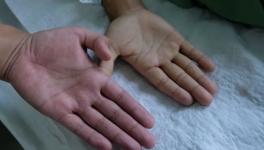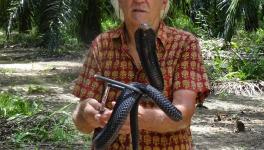‘Prevention is Better than Prosecution’: Success Stories from Scotland and US to Combat Violence

Can violence be thought of as an infectious disease and treated in a similar way that other infectious diseases are treated? Scotland and US started with this idea and have designed procedures for handling violence. In the 1990s, the USA, and Scotland in 2005, adopted violence handling through a public health approach and to their satisfaction, violence handling procedures have brought significant positive results where Scotland could reduce incidents of violence by as much as 60 per cent.
In 2005, the United Nations reported that Scotland was the most violent among the developed countries. In the same year, the WHO declared Scotland as the murder capital of Europe. In the early 2000s, the casualty wards of the hospitals in Glasgow would often have people with injuries on the face, jaw, neck and head. Sometimes a baseball hit would be the cause of the injuries, while sometimes it would be a knife slashing over the face or neck. These injuries were not because of car accidents, nor were those incidences of sports injuries; these injuries were due to incidences of violence that had overwhelmed Scotland.
Christine Goodall, the maxillofacial surgeon in Glasgow had many experiences to share. One night, a young man came to the hospital with a knife wound across his face. Goodall, fairly upset, told the young man that his facial scars could not be changed, and will stay on his face. But to Goodall’s utter surprise, that guy di not look too concerned. Dr. Goodall didn’t have to wait for long to find out why the guy was so cavalier about his injuries. In the afternoon, that guy’s group of friends came visiting and Dr. Goodall observed that all of them had the same scars. The young man had only joined their club. That’s when Goodall realised the gravity of the worsening situation in her town.
Goodall continued stitching up such wounds. But there was no sign of the incidents going down, instead, often the same people would visit the hospital over and over again, with injuries of violent attacks.
However, soon something innovative came along, that too from the police, to deal with this violence. In 2015, the principal analyst of Strathclyde police, Karyn McKluskey reported that the conventional ways of the police has not been fruitful in reducing violence in the society and something else needs to be done. Her initiatives led to the formation of the Violence Reduction Unit (VRU), right now a part of the Strathclyde Police, Scotland.
The role of VRU in Violence Reduction
The WHO guidance on violence prevention identifies that violence need not be thought of as an inevitable part of human society. It suggests that violence can be prevented and reduced in a similar way that public health efforts have contained infectious diseases, pregnancy related problems, workplace injuries etc. Whatever the factors giving rise to violence, be it related to attitude and behaviour, or socio-economic-cultural situations—they can be changed.
The strategy of the VRU in tackling violence has been similar to the approach of public health. In the realm of public health, prevention of the spread of any epidemic is the first thing to do. Public health officials firstly map the area where transmission of the disease is the most, and then they focus on preventing the spread in those areas. Many serious health problems like HIV, emphysema, heart disease are habit related, like smoking, overeating, unprotected sex etc. Prevention of these diseases demand habit change and also changes in group norms.
Likewise, the VRU concentrated on preventing the spread of violence at the first place. Violent behaviour itself becomes an epidemic and spreads from one person to another. Although social violence incidences involve many complicated issues like poverty, lack of education, unemployment etc., the first line of defence could be the prevention of spreading violence—at least the VRU started with this idea.
The VRU puts together teams of police officers, researchers, civilian staff and most importantly former offenders. The inclusion of former offenders in the VRU is important because it had been observed that often the offender in previous cases become the perpetrators of later crimes too. The hospital records showed that the people with injuries of violent incidences like knife attack, fighting etc. in previous cases often come again with injuries sustained in similar incidences—Dr Goodall analysed.
The VRU employs people called as ‘navigators’ whose job is direct intervention in incidents of violence with the aim of diffusing the tension and to help people find support. These navigators work in emergency and accident departments of hospitals and approach people who come to these departments after such violent incidents. Many people get engaged in violence with the aim of revenge. The navigators approach them and try to convince not to get involved in such acts again. After initial conversations the navigators get them drug or alcohol treatment, job opportunities or further therapy, as and if needed.
Now, the VRU of Scotland police is the first squad to formally adopt a public health approach in tackling violence. With the VRU in function, Scotland no more bears the tag of being the most violent among the developed countries.
The US Case: ‘Cure Violence’
Like the VRU, similar initiatives were also taken in the USA back in the 1990s. In fact, the VRU model was inspired from the US initiatives and also adopted some of their approaches. Cure Violence is a Chicago based organisation started by Gary Slutkin, the American epidemiologist. Mr. Slutkin used his experience of public health while he was posted in Somalia in projects handling TB and Cholera prevention. Back in Chicago, Slutkin started his work in reducing violence through the public health approach. VRU’s navigators are taken from the ‘violence interrupter’ used in Slutkin’s project. Cure Violence is right now based in the public health department of Illinois University. According to a survey of Johns Hopkins School of Public Health, the violence rate has gone down significantly in the areas where Cure Violence has been at work.
Get the latest reports & analysis with people's perspective on Protests, movements & deep analytical videos, discussions of the current affairs in your Telegram app. Subscribe to NewsClick's Telegram channel & get Real-Time updates on stories, as they get published on our website.
























